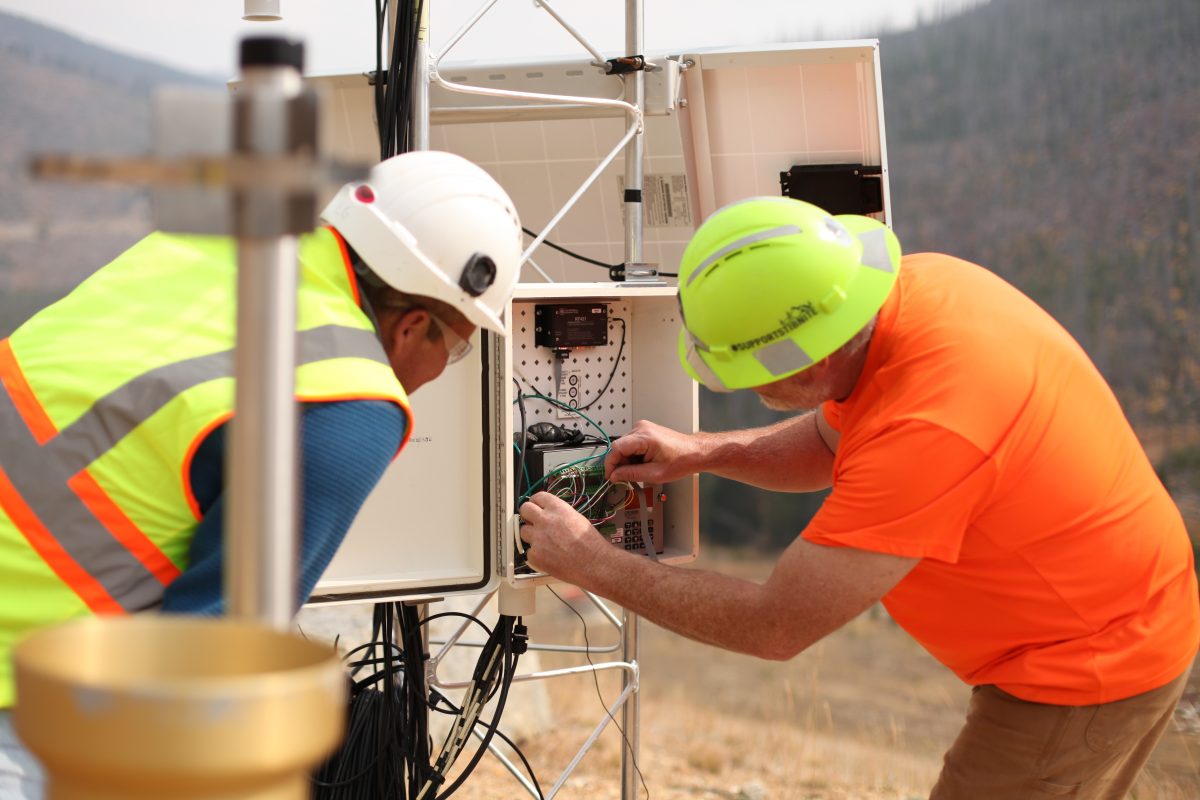Making Mining a Reality
Before the Stibnite Gold Project can move forward, the federal government must review the plan under the requirements of the National Environmental Policy Act (NEPA). Then, Perpetua must earn more than 50 permits from federal, state and local agencies and set aside millions of dollars to guarantee reclamation.
NEPA is designed to make federal agencies consider the environmental, social and economic impacts of any proposed projects on public land. Community members can be involved by providing comments about our project.
During the public comment periods on the 2020 Draft EIS and Supplemental Draft EIS in 2022, thousands of people wrote in to support the Stibnite Gold Project. Perpetua and the US Forest Service have used public comments to improve the project design and environmental outcomes.
To learn more about the permitting process, click here.

The Project Timeline
Exploration
During exploration, our goal was to determine if the project would be economically, environmentally and socially feasible. It is.
We identified the site as a world-class source of gold and antimony right on our doorstep.
We dedicated years to studying the environmental needs of the site and engaging community members and stakeholder groups. We gathered ideas, listened to concerns and found solutions.
Pre-Feasibility Study
In 2014, we released our Pre-Feasibility Study, which compiled our research, outlined the best ideas for mining and identified areas that needed further investigation.
You can read an executive summary of our
Pre-Feasibility Study .
Plan of Restoration and Operations
We provided our Plan of Restoration and Operations, known as the PRO, to the U.S. Forest Service in 2016. This comprehensive plan outlines how we will mine the Stibnite Gold Project site and progressively restore the area.
Click here to view the plan summary, or visit the U.S. Forest Service website.
Environmental Impact Statement
The Environmental Impact Statement (EIS) is the result of an environmental review of the Plan of Operations conducted by the U.S. Forest Service to assess the impacts and benefits of the Stibnite Gold Project. The U.S. Forest Service released its Draft EIS in August 2020 and its Supplemental Draft EIS in October 2022. After a thorough technical review and considering public input, the agency will release its Final EIS, along with its Record of Decision.

Permitting
After the U.S. Forest Service publishes its EIS and a Record of Decision, Perpetua must then earn more than 50 permits, licenses, approvals and authorizations from federal, state and local agencies. During the permitting phase, we must also calculate and obtain sufficient financial assurance to guarantee the ultimate completion of the approved restoration.
Construction
Before we begin construction, Perpetua will set aside millions of dollars in a trust for reclamation of the site. During construction, we will begin cleanup of the impacts from historical mining activity. We anticipate construction will take about three years and employ 500 people directly, while creating an additional 300 jobs in the community.
Mining
Once construction is complete, we anticipate the mine will operate for at least 12 years, directly employing over 500 individuals and supporting the creation of another 500 jobs in the community. During mining, we expect to recover gold and antimony, and concurrent to mineral production, we will continue to address many of the environmental legacies left behind at Stibnite.
Reclamation and Closure
Before Perpetua begins construction, we will provide state and federal regulators with millions of dollars in Financial Assurance to guarantee environmental restoration work is fully funded. Substantial repair of historical impacts will occur alongside construction and mining. Once mining is completed, we will dismantle the buildings on site, restore the natural habitat and monitor and protect the health of the area in the years that follow.
HOW THE NATIONAL ENVIRONMENTAL POLICY ACT (NEPA) WORKS
Step 1: Federal Agency Submits a Notice of Intent to Prepare an Environmental Impact Statement
Since some parts of the Stibnite Gold Project will take place on federally managed public land, Perpetua Resources submitted a plan to the U.S. Forest Service, the lead federal agency on the project. The NEPA process started when the U.S. Forest Service announced it would prepare an Environmental Impact Statement (EIS) for the project and give the community an opportunity to provide feedback on the proposed plan.
In Perpetua’s case, there are many additional state and federal agencies reviewing the Stibnite Gold Project, including:
- Environmental Protection Agency
- NOAA Marine Fisheries
- U.S. Fish and Wildlife
- U.S. Army Corps of Engineers
- Idaho Office of Energy and Mineral Resources
- Idaho Department of Environmental Quality
- Idaho Department of Lands
- Idaho Department of Fish and Game
- Idaho Department of Water Resources
Step 2: Agency and Public Scoping
Scoping identifies important issues that need to be addressed in the EIS. The U.S. Forest Service did an internal review on the Stibnite Gold Project before asking individuals and organizations to submit comments and provide recommendations in 2017. Several important issues came to light through public feedback, including project footprint size, public access through site and transmission line location, as well as concerns about protecting water quality and fish populations and habitat. After listening to this feedback, Perpetua submitted several alternatives and plan modifications to the U.S. Forest Service to reduce the project footprint, provide seasonal access to site and reroute the transmission line away from residential property where possible. Perpetua also submitted detailed plans for protecting and enhancing water quality, fish populations and habitat.
Step 3: Prepare a Draft Environmental Impact Statement
The U.S. Forest Service worked on its Draft EIS (DEIS) for the Stibnite Gold Project for several years. The DEIS is designed to provide analysis on how a proposed project may impact the environment and how to offset or avoid such impacts. In Perpetua’s case, the DEIS included the Stibnite Gold Project’s original Plan of Restoration and Operations and several alternative proposals, including our updated plan that incorporated changes resulting from community and agency feedback.
Step 4: Public Comment and Refinement
Perpetua’s DEIS was released by the U.S. Forest Service in August 2020, after which, the public had 75 days to comment on the document. More than 9,000 individual comments were submitted, 85 percent of which were positive. After reviewing the public comments on the 2020 DEIS, Perpetua proposed updates to the project design to make its environmental outcomes even better. The U.S. Forest Service then released a Supplemental Draft EIS (SDEIS) in October 2022, which received more than 19,000 comments over a 75 day public comment period – the vast majority of which expressed support for the Stibnite Gold Project.
To learn more about the SDEIS, click here.
Step 5: Final EIS is Released
In Step 5, the U.S. Forest Service will look at the comments received in the 2022 SDEIS and conduct any additional analysis needed to prepare the Final Environmental Impact Statement and Draft Record of Decision. The Final EIS must address all substantive comments received during the comment period.
Step 6: Record of Decision
After all the steps above are completed, an immense amount of data has been evaluated and the public has weighed in, the U.S. Forest Service will publish its Final Record of Decision (ROD), giving Perpetua Resources its blueprint for the life of the Stibnite Gold Project.
Step 7: Financial Assurance
Before beginning construction of the mine, Perpetua Resources and the lead regulatory agencies will use the Record of Decision to calculate how much it will cost an independent contractor to complete all reclamation and restoration work at the site. This amount will be provided to the agencies using accepted financial assurance tools before construction or mining begins.
Want to know more about financial assurance? Read our blog to learn more about changes Idaho recently made to enhance protection of our lands.
Step 8: Ancillary Permits
In addition to receiving a Final Record of Decision, Perpetua Resources must obtain approximately 50 additional permits for various aspects of operations. These permits, some of which can be obtained before a Final ROD and others of which are only granted after, provide additional checks and balances to ensure the project is done right.
Only after receiving a Record of Decision and obtaining all the necessary permits can the Stibnite Gold Project officially begin construction.
Learn more about the permitting process by visiting the U.S. Forest Service’s website.
Get all of the facts on our proposed Stibnite Gold Project.
Learn MorePLAN OF RESTORATION AND OPERATIONS
Perpetua Resources delivered its Plan of Restoration and Operations to the U.S. Forest Service in 2016. You can view Perpetua’s plan and see how it has evolved through the permitting process here.
If you have any questions, please reach out to [email protected] or stop by Perpetua’s Donnelly office.
